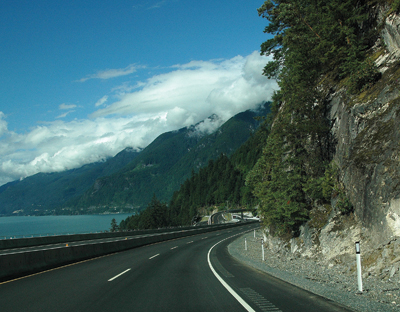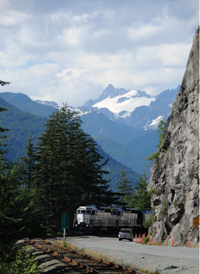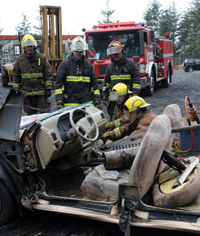
Headlines
News
Olympic challenge
The Sea to Sky Highway is the only road link between Vancouver and Whistler. Formerly a narrow, winding, mostly two-lane undivided road, it earned a reputation as a killer highway because of the frequency and spectacular nature of accidents along its 100-kilometre length.
July 27, 2009
By Paul Dixon
The Sea to Sky Highway is the only road link between Vancouver and Whistler. Formerly a narrow, winding, mostly two-lane undivided road, it earned a reputation as a killer highway because of the frequency and spectacular nature of accidents along its 100-kilometre length. Key to the winning bid to host the 2010 Winter Olympics was a commitment from the provincial government for a $600-million upgrade that is now reported to be in excess of $900 million.
 |
|
| A newly constructed median on much of the Sea to Sky Highway between Vancouver and Whistler could pose problems for emergency vehicles that need to get to collisions on the other side of the narrow, winding road. Photo by Paul Dixon. |
Olympic traffic through the Sea to Sky corridor has the potential to create chaos. With three venues in Whistler (downhill skiing and sliding sports) and the nearby Callaghan Valley (biathlon, ski jumping and cross-country skiing) VANOC is assembling a fleet of buses from across North America to move thousands of spectators, officials and media into Whistler every morning during the Games in February and return them to Vancouver in the evening. Additionally, thousands of workers and volunteers must be transported in from Squamish every day. The impact of a single accident on the highway could result in a traffic jam stretching for kilometers.
Four fire departments respond to incidents on the Sea to Sky Highway – West Vancouver, Lions Bay, Squamish and Whistler – a combination of career, composite and volunteer services. BC Ambulance Service provides coverage from stations in West Vancouver, Lions Bay, Squamish and Whistler. In 2007 there were 760 reported accidents on the highway, 330 injuries and two deaths. BC Ambulance responded to 397 accidents on the highway, with the appropriate fire department responding accordingly. Putting these statistics in perspective, during 2007 much of the highway was under a 50-km/h construction zone speed limit. Even at that, a significant number of accidents required extensive extrication work. Lions Bay’s 25-member volunteer department responded to about 80 calls on its 30-kilometre stretch of highway with 12 of those classed as major extrication incidents, the result of head-on or vehicle-versus-rock-face collisions.
All four fire departments have a high degree of expertise in auto extrication and all four are well equipped to respond to light- and medium-level calls, but they lack the resources and expertise to adequately deal with large vehicles such as multi-passenger buses or motor coaches. The money required for additional equipment and training is beyond the departments’ budgets and no other agency or level of government has anted up.
The Sea to Sky is actually two very different roads. From West Vancouver north to Squamish it is a coastal, seaside highway; the road between Squamish and Whistler is a mountain highway subject to extreme winter driving conditions. Geologists say the road could not have been built in a worse place but there was nowhere else to put it. Along the length of the highway, the layers of rock from which the road has been carved look like a gigantic deck of playing cards tilted towards the road. When pieces break loose they have nowhere to go but downward. Rainwater and melting snow percolate through the rock face and the daily freeze-thaw cycle over the winter coupled with ongoing regional seismic activity adds to the stresses, leading to catastrophic failures in the rock. In July 2008, 16,000 cubic metres of rock came down on the road at Porteau Bluffs midway between Lions Bay and Squamish, closing the highway for three days.
 |
|
| The illusion of wide-open spaces gives drivers an opportunity to exceed the 80 km/h speed limit on the Sea to Sky Highway. Fire officials are worried about the potential for accidents during the 2010 Olympics and the abilities of the four fire departments along Highway 99 to do extrications on the large motor coaches that will transport athletes, spectators, media and volunteers along the 100-kilometre route. Photo by Paul Dixon. |
Falling rock on the road, from handfuls of gravel to boulders the size of cars, is a constant threat. Apart from the obvious effects of a major rock fall, there is constant danger of vehicles driving over smaller rocks at highway speed, falling rocks striking moving or stopped vehicles and simply damage to the road surface itself. Thousands of metres of wire mesh have been suspended over rock faces to control loose rock; steel bolts anchor entire rock faces and shotcrete has been widely used. In some sections all three techniques have been used on the same exposed rock face.
The province started work on the highway upgrade in September 2004 and it is projected to finish ahead of schedule in September. Some of the improvements include more than 80 kilometres of new passing lanes, 36 kilometres of centre median barrier (between West Vancouver and Squamish), redesigned intersections and new or widened shoulders.
The upgraded sections include additional four-lane and three-lane divided stretches, although there are still significant stretches of two-lane road. Two-thirds of the road between Squamish and West Vancouver is now separated by a concrete median, installed because the daily average traffic volume has reached the critical level of 14,000 vehicles. The new highway offers spectacular views and the illusion of a wide open road, but it is quickly apparent when driving it from the perspective of an emergency vehicle operator that it is in many ways as challenging as the old one, with narrow shoulders and short sightlines.
Olympic traffic management will ensure tight controls on vehicular movement on the 40 kilometres of highway between Squamish and Whistler. There will be no public parking in Whistler for the duration of the Games. The only vehicles allowed past the security point north of Squamish will be those of residents, visitors with passes and Olympic transportation. Up to 30,000 spectators a day will view events at the sites in and around Whistler, the majority of them transported in each morning by a fleet of 200 motor coaches and returned to Vancouver at the conclusion of the day’s competition. While athletes competing in Whistler will be housed there, they will have to be brought into Whistler, along with thousands of officials, media and volunteers who will be bussed in daily. Moving that many people on tight timelines requires open roads.
Highways maintenance contractors will add extra crews and equipment for the duration of the Olympics to keep the roads bare, salted and sanded around the clock. RCMP will have a large contingent responsible for traffic control along the entire length of the route but fire departments are hard pressed to provide a level of service above their current municipal mandates.
Planning for fire-department response and road rescue started in 2006 with the Fire Rescue Advisory Board to the 2010 Olympics, made up of representatives of the local firefighting community, VANOC and the provincial government. Initially, a 10-minute response goal for motor vehicle accidents along the Sea to Sky corridor was established. Given the distances involved and the challenges for volunteer firefighters to get to an accident scene even under the best conditions, it became apparent that the 10-minute goal was not achievable without incurring considerable expense. There was talk among officials of establishing points along the route where ambulances, fire trucks, heavy tow trucks and other equipment could be pre-positioned but there was no obvious source of funding for these resources and the idea was scrapped. The fire departments along the highway can’t remove apparatus from their communities and maintain adequate response levels. Even if they could, they’d be relying on their volunteers to donate their time. While BC Ambulance plans to bring in paramedics and ambulances from across the province to meet its Olympic responsibilities, BCAS is already running 10 per cent short in daily staffing across greater Vancouver.

|
|
| Firefighters with the Lions Bay Volunteer practice extrication in advance of the 2010 Olympics. Lions Bay is one of four departments responsible for the Sea to Sky Highway between Vancouver and Whistler. Photo by Paul Dixon. |
It is understood by emergency response personnel that money will be made available to each of the four fire departments to staff one piece of apparatus specifically for highway rescue response 24/7. The municipalities do not have the financial resources to pay for this, VANOC says this is not within its mandate and while all eyes are on the provincial government, the impact of the deepening recession on government revenues coupled with widely reported cost overruns on many other Olympic-related projects has resulted in silence with just six months before the Games begin.
Enforcement along the Sea to Sky falls to West Vancouver Police and the Sea to Sky detachment of the RCMP, which generally has two highway patrol members working the 90-kilometre stretch between West Vancouver and Whistler over which it has jurisdiction. The RCMP will bring in teams of traffic specialists including accident investigators and analysts from across the country to deal with collisions on the Sea to Sky during the Games but traffic management officials appear to have given little thought to the fact that drivers and passengers may need to be extricated from vehicles before investigators take over a scene.
Interviewed separately, Sgt. Tim Kravjaski of West Vancouver Police and RCMP Cpl. Dave Ritchie expressed similar opinions of the road and those who use it.
“The new highway is posted at 80 km/h,” says Kravjaski. “The road, the on ramps and the off ramps are designed with sightlines for 80 km/h. The first weekend the section of the highway was opened [in May] through West Vancouver, I would estimate the average speed was 110 km/h. We wrote well in excess of 200 tickets that weekend. The shoulders are 1.5 metres wide, meaning that broken down vehicles will be obstructing the road and there are very few places for emergency vehicles to turn around.”
The new road presents the illusion to motorists that they should be driving much faster than the posted 80-kilometre speed limit. The speed limit is 80 km/h because of the geometry. The simple appearance of the old road was enough to keep the average motorist close to the posted speed limit (the same 80 km/h) but the sweeping vistas and spectacular views of the new road create the illusion of wide open spaces. Driving the new road out of West Vancouver is not unlike bobbing around on the open ocean in a small boat. The road rises and falls away constantly, with one sweeping corner after another. There are few straight lines on this road. The road is seductive in that it is far too easy to over estimate one’s ability to see far enough ahead when coming over a hill or around a curve. Narrow shoulders and a centre median give little room to maneuver if one suddenly comes upon a broken down vehicle or an accident.
The narrow shoulders and centre divider also make it difficult for emergency vehicles to move through stopped traffic to get to an accident scene, as stopped vehicles have nowhere to go. The minimal sight lines make it extremely dangerous for responders to stop on the opposite side of the divider from an accident, as they are often exposed to oncoming traffic. Lions Bay fire chief Andrew Oliver says that historically his firefighters would not stop on the opposite side and climb over the centre median, but instead would drive on, turn around and come back up to the scene. The new centre divider means there are few places for emergency vehicles to turn around. Sgt. Kravjaski agrees that it is “not desirable” for responders to be stopped on the other side of the road.
Cpl. Ritchie doesn’t foresee a decline in the number of accidents, but he thinks there will be a significant change in the types of accidents. “We’ll see an increase in speed. There will be fewer cross-over, head-on crashes, but there will be more ping-pong and rear-end accidents as a result of increased speed and vehicles constrained to one side of the highway.”
A keystone to the planning for the Olympics has been the promotion of legacies to benefit communities in British Columbia. The upgrades to the Sea to Sky Highway are held up by the provincial government as a legacy for the communities along its length. Many local politicians and civic boosters looked for big dollars from senior governments to create legacies for their communities in new buildings and capital projects. Whistler Fire Chief Rob Whitton is more realistic. When asked what he wants as an Olympic legacy for his department and community, he replied simply, “I want everyone to have a good time and get home safely.”
Print this page